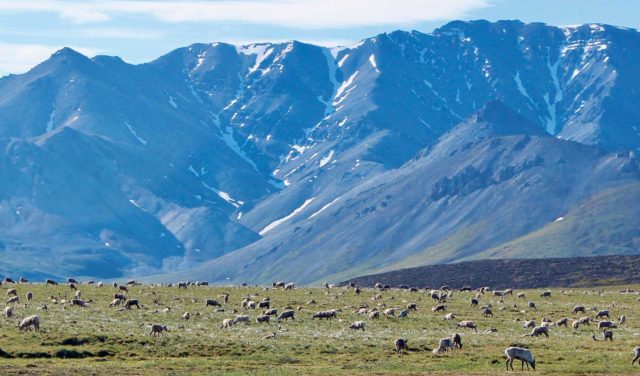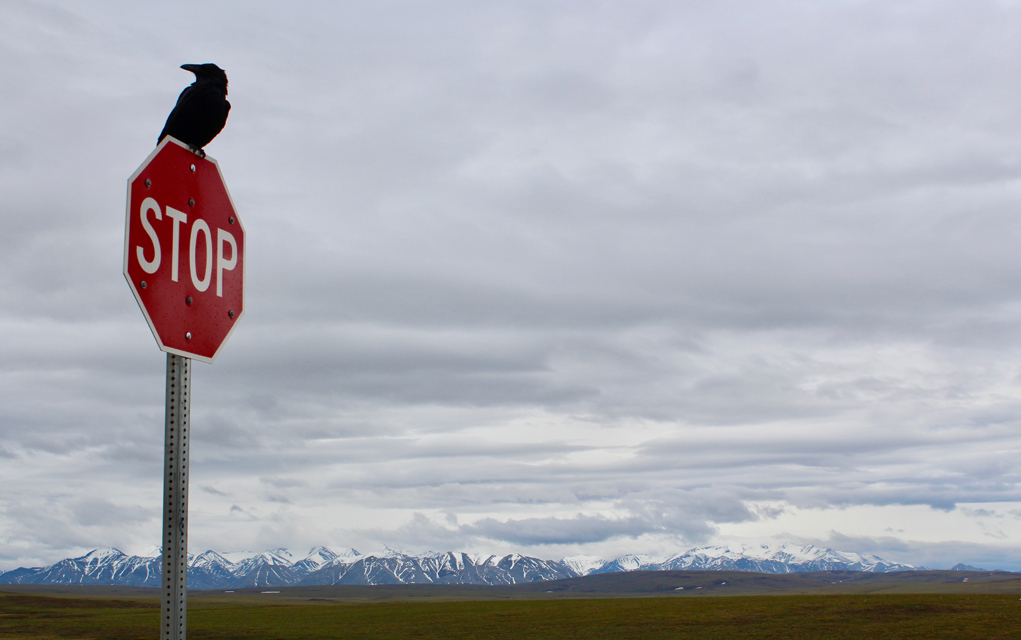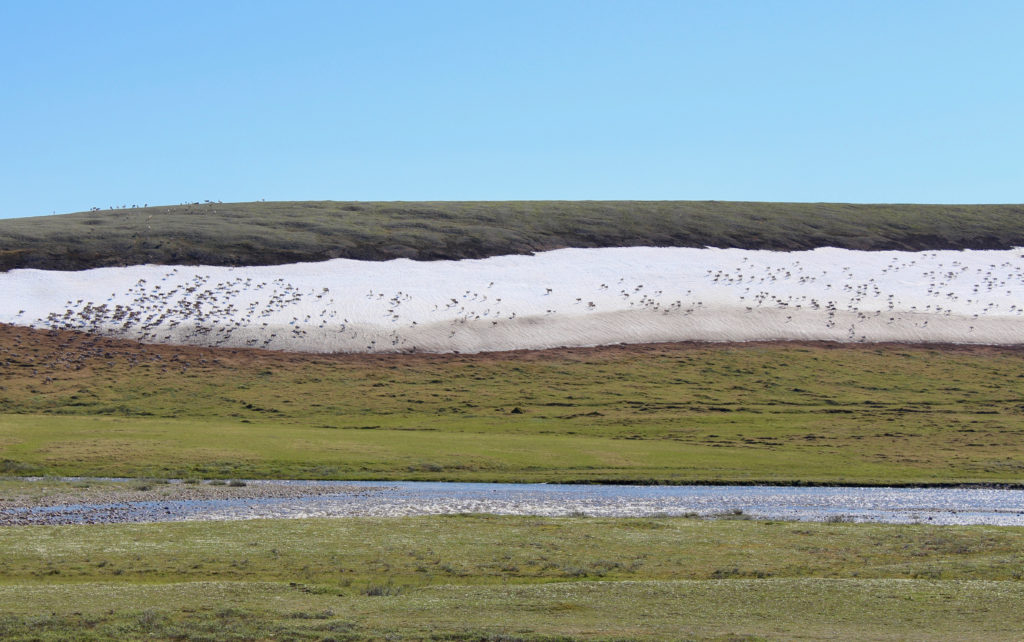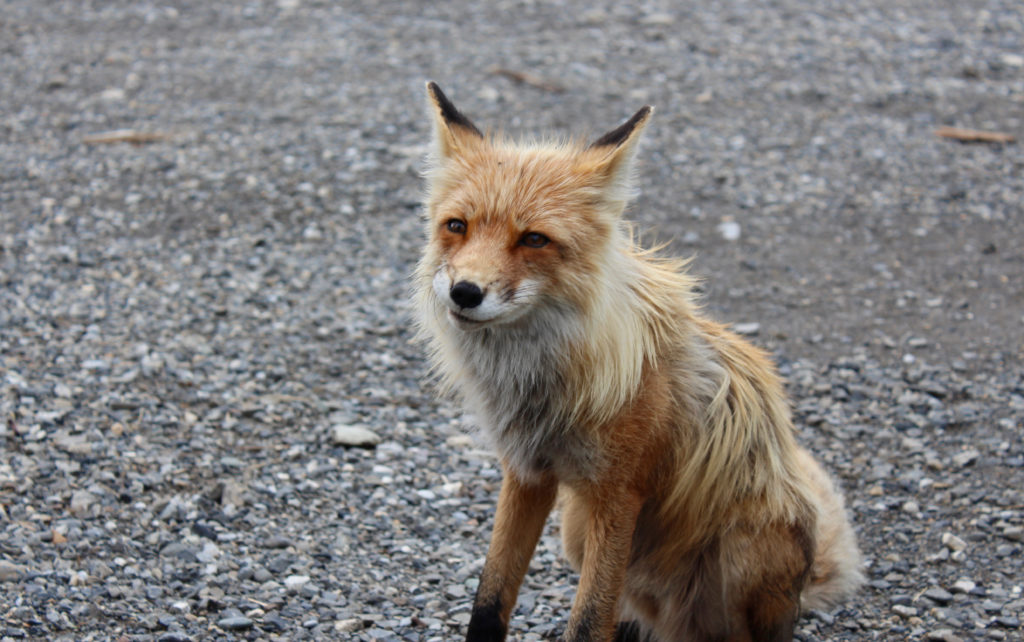
Outside my nylon cocoon, a high-pitched buzz pulsed: enemies at the gates. Enemies that would devour me alive given the chance.
I was holed up in my two-person expedition tent on the Alaskan Arctic tundra, making every excuse not to go outside — to avoid facing the parasitic insect horde that hovered in wait.
Not that I wanted to stay inside that tent. I wanted nothing more than to crawl outside, to stretch my legs and explore the wild region I’d been camping in and flying over for the better part of a month. I wanted to roam the ancient lands, to hunt for buried mammoth tusks and lost eagle feathers.
But, for several days it had either been raining steadily or, when the drizzle did abate, swarming with thick clouds of mosquitoes (which might be mistaken at first glance for small bats).
These were not uncommon conditions for this part of the world. But they had put a damper on my ability, and incentive, to break free and explore.
Besides, there were monsters out there — some that wanted more than a small drink of blood — and I was unarmed. I was several links down in the food chain and except for the tens of thousands of dollars of camera gear that I’d been left to “guard” and a half-empty can of bear mace, my solitary encampment in the Arctic National Wildlife Refuge (ANWR) was defenseless.
Alaska’s ANWR is unlike any other place on Earth. Depending on where you get your news, it might sometimes be framed as a wasteland, as an empty, swampy, lifeless place that’s only value is in the fossil fuels buried beneath it.
But nothing could be further from the truth.
More than mosquitoes, the ANWR is home to grizzly and polar bears, gray wolves, dall sheep, muskoxen, Arctic foxes, birds of prey, a few (very sparse and isolated) local native settlements and, of course, the massive caribou herds that dominate the land.

The part of the ANWR I was in is known as the “North Slope,” the “1002 Area” or “America’s Serengeti.” It’s a grassy rolling tundra corridor broken only by braided rivers running north from the Brooks Mountains across the coastal plains and into the Arctic Ocean, at the northeastern-most point of the 49th state.
There are no roads in the ANWR, as wheeled vehicles are forbidden. There are no trails except those carved by animals. There are no towns or cities for hundreds of miles. It’s a wilderness in the true sense of the word — one that is crucial to many different species today, as it has been for tens of thousands of years.
Conservationists, environmentalists and nature enthusiasts have been fighting to protect this area from fossil fuel interests ever since oil and gas were discovered here in the early 1960s.
For a long time, it seemed like a fight that they were winning; a fight that could ultimately be won.
But things have changed — and not in the interest of the ANWR or the animals who call it home. Now, in the twilight of the fossil fuel era, as climate change intensifies all around us, this Arctic Eden has been opened up to be sold off; to be drilled, defiled and exploited at the hands of oil and natural gas companies.
• • • •
I was there in 2016, just months before the last presidential election, waiting in my tent for my employer, Florian Schultz (a documentary filmmaker and photographer) and Jake, our bush pilot (whose last name I never quite caught), to return and pick me up.
I’d been stranded.
We were supposed to be filming a massive caribou migration. But the problem our three-man team had encountered after venturing deep into the ANWR was one of weight. We had too much of it. Between three fully grown men and another 150-plus pounds of camera gear, Jake’s nimble, but very light, two-seat single-engine Super Cub bush plane could not safely fly everyone and everything all at once.
So, we developed an (admittedly flawed) system: Florian and Jake would go scouting, carrying minimal camera gear. When they found some caribou action, Jake would drop Florian off with minimal equipment, take off again, come back and pick me up with the rest of the gear. Then he’d shuttle me over, and Florian and I would get down to business.
When the caribou had passed us, we would rinse and repeat.
Except several days ago (Two? Three? Five? Hard to tell in the land of the never-setting sun) these pregnant gray clouds had rolled in and settled down low, right on top of me. Which, as any bush pilot will tell you, is no-fly weather.
So I was stuck. Jake could not reach me, and Florian could not reach his gear. It was a predicament for us all.
We’d been out working on Florian’s film The Refuge for several weeks, filming bears and scattered caribou groups. But we hadn’t found the fabled Porcupine Herd, a family of some 218,000 antlered beasts that would be thundering through the 1002 Area any day, traversing frigid rivers, storming over mountainsides, outrunning bears and wolves (sometimes), getting eaten alive by mosquitoes, grazing, drinking and migrating, always, in a 1,500-mile clockwise circle — a never-ending diaspora that has been in motion since the Ice Age.
At the time, things were looking very hopeful for the ANWR. President Obama had used some of Florians’ footage in a campaign ad in an attempt to federally designate the region a wilderness area. This designation would’ve made it nearly impossible for oil and gas developers to worm their fingers into that precious landscape.
But that wilderness designation never came to pass. Not long after my time in the ANWR was over and I had returned to the lower 48, America had elected a new president, one who would undo decades of conservation progress with a tax bill that would open up the ANWR to be leased off, block by block, to corporate interests.
In what politicians call “pro-growth tax legislation,” the Tax Cuts and Jobs Act of 2017 is the largest overhaul of tax code in three decades. It reduces corporate income tax rates by 14%, shifts income tax brackets for the middle class, places an expiration date on many tax benefits intended to help individuals and families, and, of course, includes a seemingly random provision to open the 1002 Area of the ANWR for oil and gas development. That provision requires “not fewer than two lease sales area-wide under the oil and gas program” — each of which must be a minimum of 400,000 acres.
That’s 800,000 acres (minimum) out of the 1,563,500 acres that comprise the 1002 Area. Which, besides being allegedly saturated with oil, also happens to be an extremely rich and sensitive ecosystem; one that’s now fair game for fossil fuel companies.
In September, the Bureau of Land Management (BLM) released its final Environmental Impact Statement for the “Coastal Plain Oil and Gas Leasing Program.” And, according to Molly Block, the press secretary for the Department of the Interior (DOI), the first land lease sale is intended to take place before the end of 2019.

“Of all the threats [the ANWR] has been under ever since they found oil at Prudhoe Bay (just west of ANWR), this is probably the most serious situation,” says Francis Mauer, a retired wildlife biologist and the Alaska chapter representative for Wilderness Watch. “If this [development] happens on our watch, it would be a colossal tragedy for that land and our relationship with Nature in general.”
Mauer has been on the forefront of the fight to protect the ANWR for most of his adult life, and earlier this year, I called him to hear his thoughts on the Tax Cuts and Jobs Act.
“It broke my heart,” he says, matter of factly. “Literally, to tell you the truth.”
The night before Congress gathered to vote on the Tax Act that assembled this leasing scheme, Mauer developed an atrial fibrillation. Mauer’s heart quite literally shuddered at the prospect that the place he had worked so hard to protect might be desecrated at long last for oil and gas.
Two days later, on Dec. 22, 2017 President Trump endorsed the Tax Cuts and Jobs Act. With a flourish of his presidential pen the ANWR was suddenly more vulnerable than it had been in 60 years.
“It just sets us further back,” Mauer says. He points out that the oil and gas program at Prudhoe Bay, which began in the 1960s directly adjacent to the ANWR, has never been reduced in size or scale. It has only ever expanded.
The same could play out in the coastal plains, in the 1002 Area. And for what? Mauer asks.
Realistically, the cumulative additional oil production from the ANWR is projected to be between 1.9 and 4.3 billion barrels of oil, according to the U.S. Energy Information Administration. That would account for 0.4 to 1.2% of world oil consumption by 2030.
As for the wildlife and natural ecosystem, Joe Balash, Trump’s appointed assistant secretary for land and minerals management at DOI, remains adamant that environmentalists and conservationists need not worry. In an interview with E&E News, Balash said that he believes drilling in the ANWR can easily be done without affecting animal populations like caribou herds:
“[W]hat we know from decades of experience dealing with caribou on the North Slope is that infrastructure in and of itself is not harmful, it does not disrupt or effect caribou behavior except during their calving period,” Balash said in the interview.
Mauer, however, has a different take. Could the oil and gas operations actually proceed without affecting caribou herd migrations?
“Absolutely not,” he says.
The caribou herd on the North Slope that Balash referenced is the Central Arctic Herd. Mauer explains that the Central Arctic Herd is much smaller than the Porcupine Herd. And because they are located farther west, closer to Prudhoe Bay, they have a lot more open space to work themselves around the oil and gas operations. The Porcupine Herd, on the other hand, is 10 times larger and has to squeeze through that narrow corridor of tundra between the Arctic Ocean and Brooks Mountains — the very place I was camped: the 1002 Area.

Mauer says if an oil field goes up in the middle of the 1002 Area (and all the roads, pipelines and infrastructure that come with it) the caribou will be displaced — they will flee from all that activity — to the south, towards the Brooks Mountains. There, Mauer says, the predator density is significantly higher and the animals will be exposed to a serious new pressure; one that the Porcupine Herd has never known.
Oil and gas operations will throw a wrench into a delicately evolved system. It has the potential to be utterly devastating, Mauer says, which will affect all the native settlements and villages in the ANWR — all the people who rely on these caribou as a primary source of food.
And that’s only to speak of the effects of fossil fuel development in the 1002 Area itself, but in fact, it will affect a far greater area. The migratory birds that fly to the ANWR to nest come from six different continents, and many of them play vital roles in other ecosystems around the globe; the caribou who migrate through the ANWR spill into Canada; and many of the hunting grounds for the ANWR’s wolves and bears extend well into the Yukon.
It’s a natural network that flows out well beyond the borders of the 1002 Area, beyond the ANWR and beyond Alaska at large. It’s a vast system and one that we don’t yet fully understand. To Mauer and many other environmentalists, disrupting that for natural resource extraction seems both irresponsible and wantonly destructive.
According to a new report on fragmentation from the Center for American Progress (CAP), only 12% of U.S. lands are permanently protected from development. What’s more, between 2001 and 2017 the U.S. lost a football field’s worth of natural area to development every 30 seconds. Although the report focuses on the lower 48 states, it documents how, since 2001, the U.S. has an additional 24 million acres of roads, pipelines, parking lots, oil fields and other human infrastructure leading to greater habitat fragmentation, which “has severe consequences for the movement and survival of wildlife and the provision of clean water.”

Matt Lee-Ashley a senior director of environmental strategy and communications for CAP, as well as one of the reports’ authors, points out that Trump has made hostility toward conservation a staple of his administration. Abolishing the legal defenses of places like Bears Ears and the ANWR for oil and gas development, is his modus operandi.
“Protections that the public assumed were in place are being rolled back. The Trump administration is essentially challenging the very idea that conservation is important to the United States,” Lee-Ashley says. “Which is troubling.”
To add salt to the wound, Trump admitted at a GOP conference in February 2018 that, originally, he had no personal interest in opening up the ANWR for this kind of exploitation. It wasn’t until a friend “who’s in that world and in that business” explained to him that this was something Republicans had been trying to do for decades that he decided to append it.
“After that I said, ‘Oh, make sure that’s in the [tax] bill,’” Trump recalled in the February 2018 speech.
So, into the Tax Cuts and Jobs Act the ANWR went, and soon the DOI is hoping to move forward with its first land lease sale.
• • • •
That bleak prospect couldn’t have been further from my mind as I sat in my Arctic solitaire, prisoner to the clouds of mosquitoes. I was warm, I had food and I was generally safe.
But I was getting bored waiting out there.
And, more than boredom, I was starting to get a sense of what it might be like to become totally, bat-shit delusional. Every so often, far-off in the distance, I’d hear something that sounded just like the Super Cub plane. So far, though, these had just been tricks of a hopeful mind. So far, the “planes” I’d thought I heard had just been auditory hallucinations — nothing more.
But this time, the noise I heard out there sounded different. This time the noise I heard as I lay there silently was distinguishable from the insect drone. It was familiar and mechanical.
I jerked upright. I sat perfectly still. I closed my eyes tightly, cocked my head and focused, just there, on the faint horizon of sound.
Was that actually the Super Cub, this time?
I exploded into action, threw on my clothes, unzipped the tent door, and rushed outside into the eager throng of mosquitoes, swimming through them like beaded door curtains. A grizzly sow and cub lumbered past some 50 yards away.
I scanned the skies.
The clouds were finally breaking. And beyond the mosquitoes’ buzz, there was definitely another sound: the hum of an engine. I stood staring in the direction I thought it came from, my assailants penetrating my fleece hoodie, sucking my blood through my gloves, crawling under my bandana to get at my neck.

Then the kite-like, orange and gray Super Cub burst through a cloud and into view. It was Jake. And he was hauling ass.
The plane circled me once, then descended, its big donut tires touching the tundra, bouncing once, touching down again and braking to a hard stop beside me. The bears bolted. I started packing things up, hastily. From the way Jake had landed, I could tell something big was happening.
He jumped out of the plane, the engine left idling.
“Hey stranger! You ready to get out of here?”
I laughed, pulling my bandana down. “You bet. But these mosquitoes are going to miss me.”
“Well let’s go. We found the herd.”
Without time to pack everything, I just grabbed the drones and climbed in, dropping into the back seat and popping on the headset. Jake jumped in behind me, closed the door, flipped a switch and AC/DC’s “Highway to Hell” blasted over the headphones.
“Let’s do this,” he said, more to himself than to me.
We took off, and I watched my tiny encampment shrink below us, thousands of dollars of gear and all of my stuff left to the mosquitoes. It would be just fine.
“Sorry about the wait, man. Those clouds,” Jake explained.
We flew southeast, toward the Brooks Mountains. The weather seemed to break before us and soon, we were flying under a blue and nearly cloudless Arctic sky. The clouds had literally just been socked in on top of my camp.
Below us, marching like an army across the land, were thousands of caribou, plowing through cobalt rivers and over the mossy rolling plains.
Jake put the cub down on a mostly flat strip of tundra, right beside a frantic camouflage-cloaked figure: Florian. I hopped out and immediately started assembling the drones.
“Let’s go, let’s go!” Florian shouted at me in his German accent. “They’re passing us quickly we need to move!”
In no time the first drone was beeping at me, ready to fly. I passed Florian the camera’s remote control, gripped my own (which controlled the drone itself) and caught his eyes for the first time in several days.
“How’d it go out there?” he asked, a smile spreading across his face.
“I had to sell your gear.”
He laughed: “I hope you got a good price.”
Then we got down to business. For the next 90 minutes we flew drones over the largest-moving mass of live animals I’ve ever seen. We captured caribou mothers helping their young across rivers, we watched as a mother grizzly bear and her two cubs charged from their hiding position, chasing caribou like a deadly game of playground tag. The antlered beasts swarmed all around us as we filmed, walked past almost within reach.
It was an eternal golden hour. Every shot had the perfect lighting, every scene was packed with color and incredible vistas. When the drones ran out of batteries, we switched over to cameras, and filmed through the daylit night and well into the early morning.
I can’t shake the sense of loss I feel now, looking back on that moment. The very land I was standing on then, filming with Florian, stands today to be plowed and paved over, excavated, drilled and developed, invaded with vehicles and construction equipment, oil workers and engineers. That system will be disrupted forever, irreparably. Those caribou might never walk the same path again.
It’s a prospect that would cost this country far more than any oil or gas operation could ever produce: a pristine wilderness; a source of true natural beauty; a pivotal ecosystem. These are things that cannot be rebuilt or recreated once they’re destroyed.
Still, despite that looming land lease sale and the prospect of oil and gas development in the ANWR, Mauer maintains his sense of hope.
“Maybe I’m overly optimistic or idealistic that the Refuge could still be saved, even at the 11th hour as it is right now, and function in a very valuable way: as a catalyst for the turning point that needs to be made,” Mauer says. “But, it makes a lot of sense to me, that we could save this place and it could serve as a symbolic gesture on our part to find better ways to exist on this planet.”














